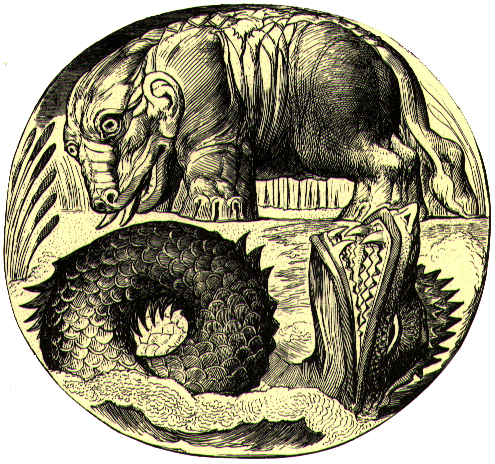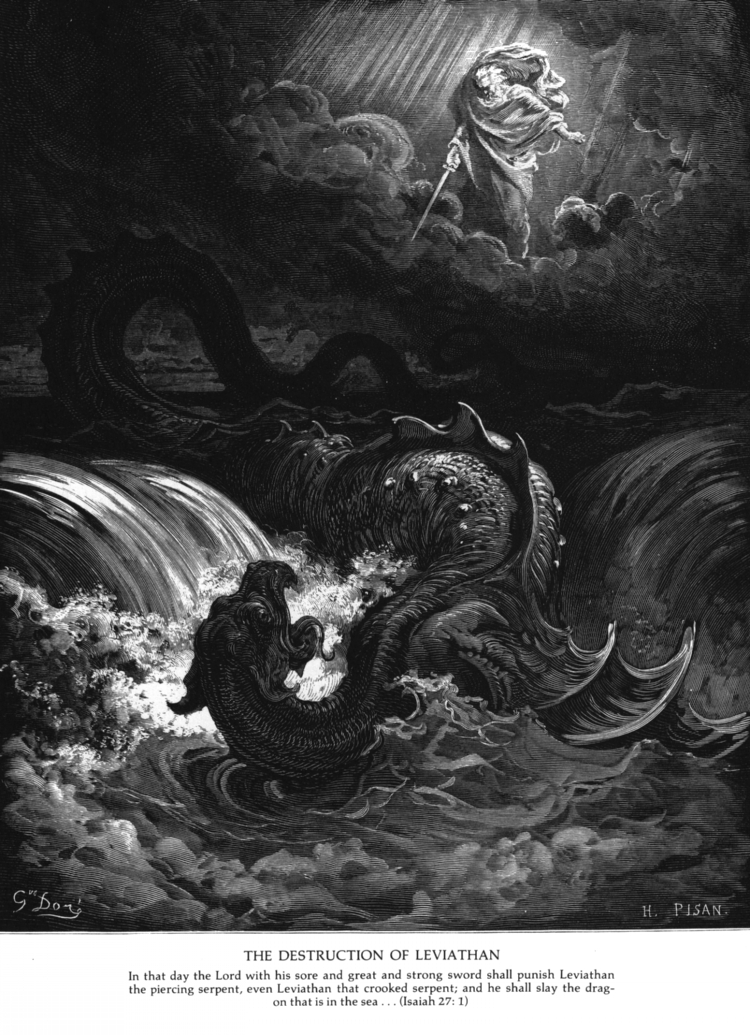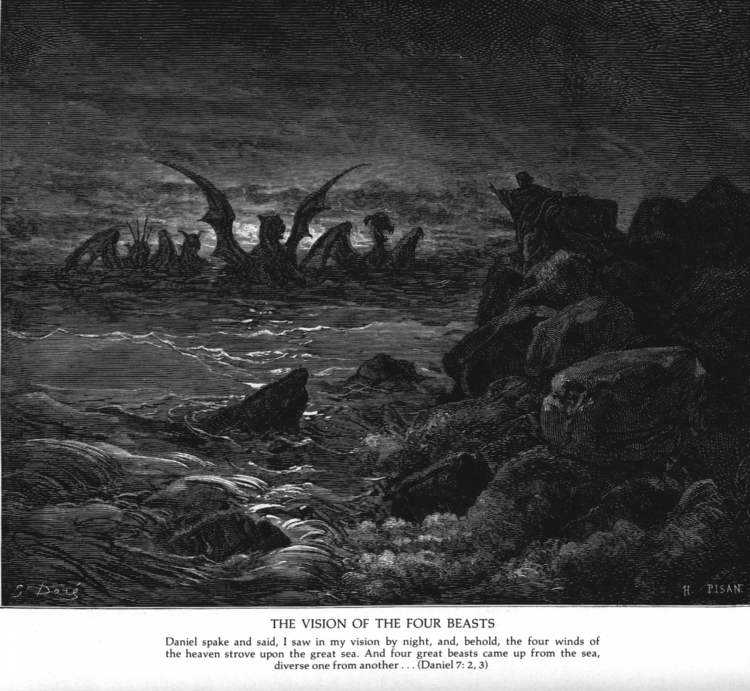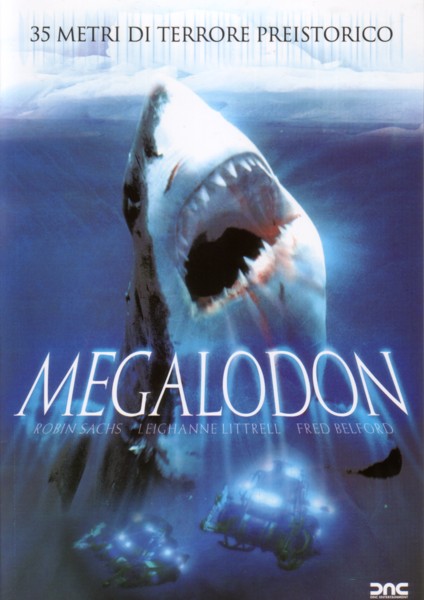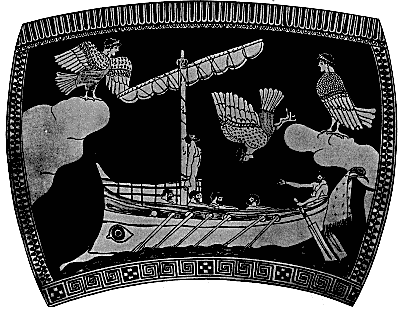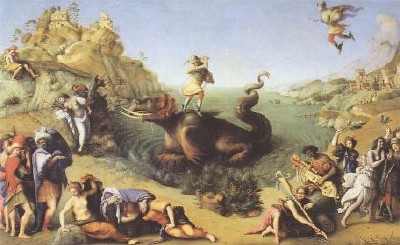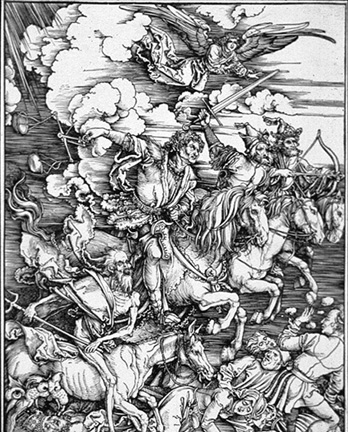The Book of Monsters of the Sea
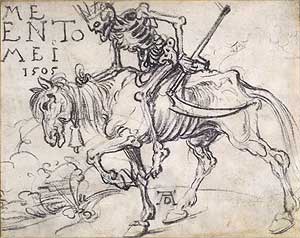
Albrect Duerer's depiction of Death Riding, showing the human interest in the supernatural forces and the personification of psychological fears.
“If monsters appear in all civilizations, in all epochs, and in the thoughts of “normal” people as well the fantasies of neurotics, it is because monsters perform a natural function.”
With respect to “monsters” in the classical sense, the realm of water provides some fine (and in some respects the only) examples of the kind. While the Fox and the Cat are uncanny, they still carry human characteristics that make resemble creatures of fable rather than creatures of nightmare. There are two monsters in the book, the great serpent and the shark (which is metamorphosed into a whale in the Disney movie and requires an analysis all by itself). Therefore, I would like to do a short analysis on (1) what a sea-monster is, (2) how it relates to Pinocchio, and (3) what visual characteristics have Collodi’s monster and the drawings can be transformed into the hypertext we are building.

William Blake's Depiction of the Babylonian King Nebuchadnezzar II. According to the Book of Daniel, after losing his sanity, he lived like an animal in the wild: defining a monster - loss of logic turning man into a beast.
The monsters of human imagination (mythologically) have carried a few characteristics. David Gilmore of New York University summarizes them into five: (1) all are giants, (2) All are hostile towards humans, (3) in terms of morphology, all are “un-natural” composites or mutants, (4) All have primitive traits suggesting an interruption from the distant, evolutionary past, (5) All these mega-beasts lurk in dark, hidden in watery places, bursting out of hiding to wreak havoc. He also noted “the motif of eating human flesh”, “paradoxical…measure of awe, even reverence about [the monsters].”
All of these traits are quite existent within the shark and the serpent. Before divulging further into the mythological “grand-fathers” of these creatures, it is important to note the “water” motif that is apparent in both mythological beasts and the beasts of Collodi. Whether it be slime or water, there is something very disgusting about the beast that adds to the horror it creates.
The grandfather of the “shark” can be traced back in European (and indeed World) mythology to the beasts of the sea that even Aristotle pondered. The uncanny within the depths of the sea in still irresolvable, since while, almost all of Earth’s surface has been (and had been by the time of Collodi) explored, the depths of sea became the final frontier of beastly apparitions. It was there, where the human subconscious could project the darker images of the self. In biblical mythology there are two monsters: the behemoth (of the earth) and the leviathan (of the sea). The Leviathan is an object of fear due to some elements that are present in all creatures: “And in that day will two monsters be separated, a female named Leviathan to dwell in the abyss over the fountains of waters”. There are two images that are clearly identifiable from the description, even before looking at graphical representations of the beast: it is female, and it is the “lady of the waters”. It controls the waters, with human sailors at its whim. Hence arises the great difference with the monsters of the land. Even in early history, humans, being able to tame the beasts of the land, made the beast spring out unnaturally in a place, which, in normal circumstances, were inhabitable by humans. 15th Century BCE reliefs show “hunts” in which Assyrian kings, kill Lions in arenas after they are released from cages, showing human superiority of over the beast. However, when it comes to the sea, humans are far from dominant. They observe the greater forces that inhabit these domains, under whose power and influence they must remain. Observe the similarity between the Leviathan, and Mazzanti’s drawing of the shark.
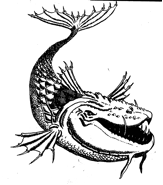
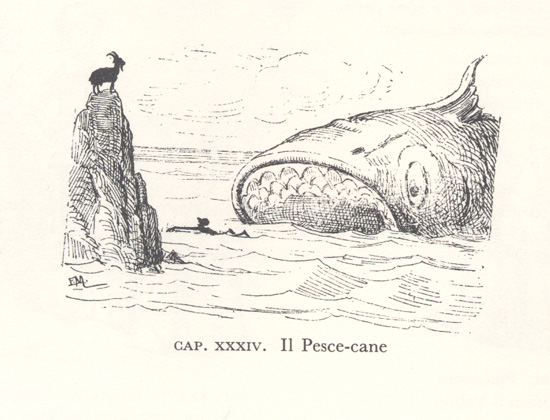
An artists's depiction of the Leviathan (top) and the shark from Pinocchio (bottom). Notice the similarities.
Both beasts have the “dragonesque” quality about them. While the Leviathan’s depiction has the whiskers and wings that one commonly associates with the beast, the shark in Mazzanti’s depiction has the “furry” fin and the enormous jaws that have the quality. As dragons were the creatures of the “skies” – another realm which humans had longed to conquer but without hope, they also mirror the horror and the fascination with the unconquerable (another version of which is depicted in the Tower of Babel in Judeo-Christian mythology).

The Dragon slain by St. George has female genitalia. This point was observed by Terry Jones in his book Medieval Lives.
A second point to note about the description of the beast is its gender – female. Why the Leviathan is a female does require a research all by itself (for which I neither have the ability nor the resources). However, it is a running trend in European mythology to associate the uncanny (especially reptilian) with the female. The dragon, which Saint George has slain, (especially in pre-Raphaelite paintings) have female genitalia. The Scylla is a woman (or at least a woman-turned-beast). There are many more examples of beasts with female characteristics (including the semi-bestial status of the Sirens), Harpies, and some of the relationship with these beasts come from the misogynistic tendencies to associate the female with the wicked, the uncanny, and the destroyer. While “male beasts” often had clear agendas (the Cyclopes being the most masculine of monsters with the ultra-masculine tendencies of drinking wine and eating good food and rebelling against the Gods), female beasts were often identified with deceptions. Sea, being the unconquerable mass of otherness that it is, housed many creatures, which without using the gentlemanly methods of dueling would resort to “hiding and attacking” or deceiving. “They were psychopomps who carried off the soul to the underworld, the personification of human guilt and fear”.
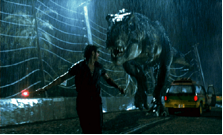
Observe that both creatures have a theme of motion around them, both are giants, both are somehow related to water.
There still are more points to note about the whale/shark of Pinocchio, historically. An important thing about the conversion to whale by Disney, is that they kept the most important horrid characteristics of the “monster” as defined above, but changed its shape. Two questions arise: (1) How is Monstro a monster, (2) Why was the shark changed into a Whale. In order to answer the first question, it is only necessary to look at the picture to the left.
Primarily, the “whale” is a giant (hence fitting in with the first requirement for a monster), it is “un-natural”: having the teeth of a shark and malicious thinking eyes of a human (and hence being a morphosis of different creatures of different realms. It lurks within the sea waiting for a specifically stormy weather to strike (the trend of slime is associated with monsters, along with their dark nature) and it has a taste for human flesh. On top of all these aspects, it sheer size, and raw power create an aura of respect for the beast. Hence, the creature fits in with all the pre-requisites of the monster. A few other things to note about the creature it the striking similarity it shares with the Tyrannosaurus Rex in Jurassic Park.
First, observe the malicious eyes of the creature that is designed and created in order to malign it as a monster – a characteristic also shared by the Whale. Secondly, its closeness and love for dark and watery places is another aspect that the Whale has. This beast also waits and strikes at a stormy night.
Secondly, the question of why the conversion to Whale arises. There are many interpretations and explanations for the metamorphosis. However, mine, is somewhat unorthodox (and probably quite wrong). However, when you look at the Leviathan, and historical representations of other watery dragons (such as giant turtles, Perseus’ watery beast, etc there is a desire to metamorphose them into a combination of mammal/reptilian/avian creatures. Even though the Shark was fetishized in Steven Spielberg’s Jaws and turned to the 30 feet beast that has “tantalizing references… to the Carcharodon megalodon, the extinct mega-shark that…may have reached fifty feat or more”– hence adding to the “pre-historic” side of the beast, it is unlikely that 1940s cartoon-makers had developed the sensibilities of the Hollywood neo-baroque (which fetishized earlier genres and utilized historical representations) through which they could turn the shark from the boring fish that it was, to the multi-dimensional character it carried in Collodi’s book and Mazzanti’s drawings. For them, it was much easier to transform the shark into a whale with the now-familiar features of a monster, than changing the classical representation of the shark.
To be clearer about my point above, I would like suggest that the whale has more characteristics of a monster than a shark, even before they both enter the realm of human representation: the whale is larger, and has an unnatural quality about it – being a mammal in the domain that is associated with fish. Although the shark devours human flesh (more often than a whale) and is more pre-historical in its visual representation, these can be distanced from the viewer by reminding them that the shark is a “fish” and hence a natural carnivorous creature, rather than a monster, whereas, adding human-eating elements and shark-like teeth to the already uncanny whale can turn it into a monster much more easily.
Using mythologies and pop-culture icons, it is now easier to place the whale and the shark within the context of “monster-ness” and the similarities and running trends within Western Literature that binds them together.
The Shark in Pinocchio is a catalyst in the literature in which Pinocchio’s metamorphosis from the spoilt child to the good boy happens. Although he does not turn into a real boy at that stage, it is foreshadowed by his growing feeling of responsibility, his desire to take matters into his own hands, and leaving the “puppet-ness” of a child and turning into the puppeteer: forcing his personality and views on people, and making them do what he wants, rather than being at whims of forces larger than he is. The reason for this cataclysm is twofold:
- Outgrowing the father figure at a time of great spiritual unease (symbolized by the shark’s belly).
- Destruction of the malevolent “father” and learning the accept his father.
The second point needs more clarification. The psychological reason for monsters in Western literature is a long subject, and one that cannot be fully analysed within the confines of this short essay. However, there are some points that can be clarified. Human beings, monsters and gods have existed for as long as humanity itself. There are monster imagery in cave paintings in Trois-Fréres dating back to 12000 BC. The duality of the monster and god in human psyche can be summarized – albeit quite deficiently– into the projection of the “father figure”(or in some cases “mother figure”) into the malevolent and benevolent: the gods and the monsters.. This projection is of the young male, who fantasizes “destroying” the father/mother who has existed since the beginning of the child’s life, symbolizing the both loving and humiliating existence. “Like imaginary monsters, one’s own parents are of course temporally prior and epigenic, occupying a mysterious prelapsarian world of which we know little. They are also (as perceived by small children) immense in bulk, I looking majestically, all-powerful and dominating.”
Hence, returning to the image of the shark having eaten Gepetto, it is easy (but maybe in some ways misled) to imagine the picture of the “father-within-father”. Pinocchio accomplishes a few things when he saves his father from the monster:
- He kills the image of the monstrous father (associated with the shark). After having saved his father from the shark, and mastering the shark, the only thing that remains within it is the frail image of an old man. The fantasy of the “immense, dominating” father has been destroyed.
- He saves and dominates his own father (in the person of Gepetto) and grows too big for him. He is now an adult, no longer afraid of his father, but his father’s savior and humiliator.
We can see the destruction of the serpent by Pinocchio’s wit and charm. It is the image of the old world which has existed since the beginning of time, devouring and destroying the passers-by being ended by the intervention of the young hero. Pinocchio’s defeat of the animal works for two purposes: (1) the comical effect of a shark that has a heart-attack by a child’s stupidity, (2) the psychological effect.
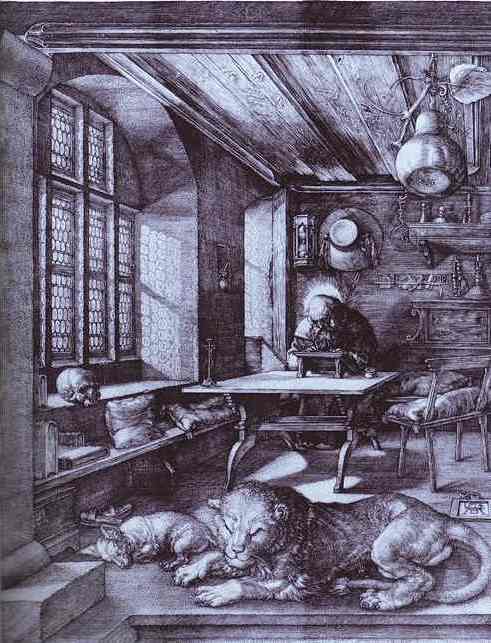
St. Jerome by Albrecht Duerer. This character's isolation is reminescent of that of Geppetto, who only through being broken and saved by Pinocchio could serve his purpose of `saving` Pinocchio.
The latter is easy to see, as the serpent dies of a heart-attack, a malady that is generally associated with elderly people. The monster, which is personified as the domineering (in the case of the serpent quite physically engulfing people with its enormous bulk before eating them) represents, as with the shark, the old system, this time disarmed and destroyed by another weapon of youth: laugher.
The last image is that of the fisherman that serves a very specific role in the text. It is again the image of the father distorted. It is a great burly strongman, who eats small children. This trend can also be observed in most other Western Literature. Kronos eats his children; most banshees are cannibalistic spirits of dead mothers. This travesty of parenthood is always challenged by the hero – always young – destroying the old and decrepit, changing the way of the world for as long as humanity has existed. The fisherman is the eternal evil father figure. He is again, fitting in with the rest of the monsters, a hybrid of a man, and the personification of the sea, combination of father-sea Poseidon, and monstrous Cyclops.
The intrinsic difference between the fisherman and the other monsters in the text is that it has logos: a human quality of deduction and the ability to use the brain, hence making it human. It eats small children, however, making it a cannibal. This distinction makes it closer to the Cyclops, who having human features, still consumes them. The monstrosity of this act again is destroyed by the New World. The fisherman, who has always existed, feeding on fish and humans, is disarmed by a friendship between the dog and Pinocchio. Bruno’s interference into the plot works to create the effect of the destruction of the eternal by the momentary. The friendship between Bruno and Pinocchio is new. It is of the New World that is portrayed in the novel. The fisherman has always existed. The New World of new friendships uproots the old system, and destroys the fisherman’s designs for the children. Monsters being a reflection of the self are overcome when they can be projected and destroyed.
